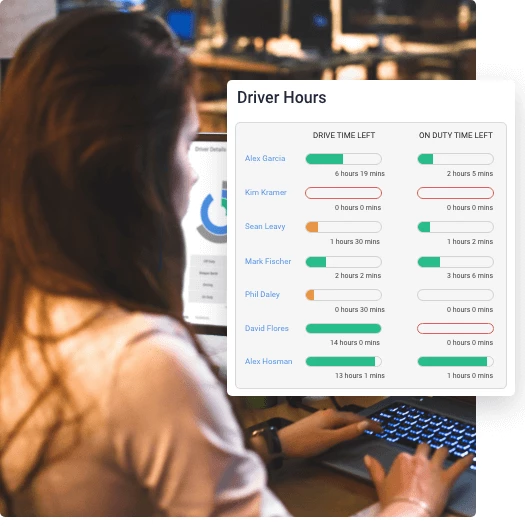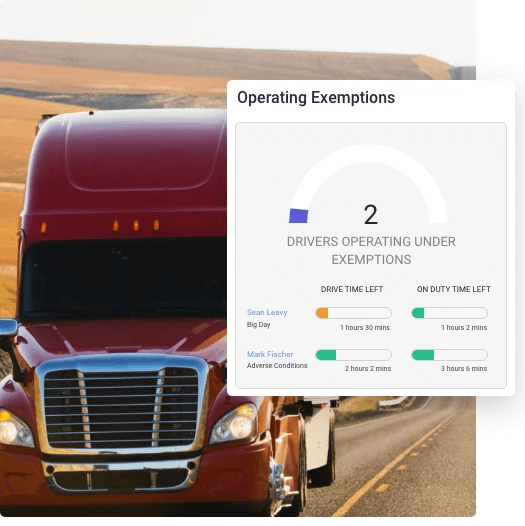Key Takeaways
DOT compliance refers to meeting the standards established in each of several DOT areas of oversight. Violation of any one of them can lead to serious consequences, and commercial motor carriers are regularly monitored to ensure they remain in compliance. DOT compliance refers to successfully meeting the requirements of the U.S. Department of Transportation, the federal agency that enforces rules (DOT regulations) governing the operation of commercial motor vehicles. Failure to be DOT compliant results in a violation of these rules. Violators are subject to sanctions that can include financial penalties (fines), suspension of a company’s permission to operate its commercial vehicle fleet, or jail time.
WHAT IS DOT COMPLIANCE
DOT compliance refers to meeting the standards established in each of several DOT areas of oversight. Violation of any one of them can lead to serious consequences, and commercial motor carriers are regularly monitored to ensure they remain in compliance.
Truckers know that the Department of Transportation issues DOT numbers that appear on equipment and in various paperwork, indicating registration with the agency. DOT regulations govern just about every aspect of the industry.
WHO MUST COMPLY TO DOT COMPLIANCE
Department of Transportation rules applies to vehicles that are required to register with the DOT and receive a USDOT number.
These can be generally described as commercial vehicles but more specifically the DOT guidelines concern motor vehicles operating under one or more of these criteria:
- Transport of hazardous materials, of type and quantity specified by DOT
- A gross vehicle weight rating or gross combination weight rating, or gross vehicle weight or gross combination weight, of 4,536 kg (10,001 pounds) or more
- Transport of more than eight passengers (including the driver) for compensation
- Transport of more than 15 passengers, including the driver
These qualifications apply to vehicles used in interstate commerce. Some states require their intrastate commercial motor vehicle registrants to obtain a USDOT number. More information is available on the Federal Motor Carrier Safety Administration (FMCSA) website.

COMPLIANCE PROCEDURE: KNOW THE DOT RULES
To ensure that commercial drivers and carriers remain in compliance with DOT rules, the place to start is with the regulations themselves. Learning the ins and outs of the DOT rulebook can be facilitated by consulting the FAQ section of the FMCSA website. This page provides a convenient list of frequently asked questions allowing the user to search under topics including regulations, driver safety, registration, licensing and more. Two key areas of compliance that business should review are:
FLEET COMPLIANCE
- Maintain a copy of the current FMCSA rules in the office.
- Complete pre-trip and post-trip inspections of vehicles, with documentation.
- Develop a vehicle maintenance program and adhere to it, with documentation.
- Ensure that each vehicle is marked with its DOT registration number.
- Maintain a record of any road incidents for each vehicle.
DRIVER COMPLIANCE
- Provide each driver with a copy of FMCSA rules, and obtain a signed receipt for the document and agreement to follow the regulations described in it.
- Maintain qualification records and safety history for each driver.
- Maintain a record of HOS (hours of service) for each driver (usually required to be via a registered ELD)
- Maintain records of pre-employment drug testing for each driver. This should also include reports of drug and alcohol abuse in previous employment if any.
- Conduct random drug and alcohol testing of drivers on a regular basis, as described in DOT regulations.
- Require supervisors to receive drug and alcohol training as required by DOT regulations.
This checklist covers the main aspects of DOT compliance but to make certain that all requirements are met, a commercial fleet manager needs to become thoroughly acquainted with DOT regulations and make the appropriate adjustments to the organization’s policy and operations. These regular reviews can help minimize the risk of noncompliance.

TYPES OF VEHICLES THAT MUST BE DOT COMPLIANT
The Federal Motor Carrier Safety Administration (FMCSA) explains: “The USDOT Number serves as a unique identifier when collecting and monitoring a company's safety information acquired during audits, compliance reviews, crash investigations, and inspections.”
The Department of Transportation states that a vehicle must be DOT registered and compliant with these regulations if it is used for interstate commerce and additionally meets one or more of the following conditions.
WEIGHT
This can apply to either the gross vehicle weight rating (the maximum operating weight, including load) or gross combination weight rating (for example, the maximum operating weight of a tractor-trailer combination). Gross weight and gross weight rating are different. The gross vehicle weight refers to the weight (including load) as measured, while gross vehicle weight rating represents the upper limit of what is allowable. DOT registration is required for any conveyance that has a gross vehicle weight rating or gross combination weight rating of 4,536 kg (10,001 pounds) or more, whichever is greater.
PASSENGERS
The number of passengers carried and the purpose they are being transported are both used in determining whether the vehicle must be DOT compliant. An automobile such as a bus or van that has a capacity of eight or more, including the driver, is registered with DOT if this is performed “for compensation,” that is, if these are paying passengers.
A vehicle that carries more than 15 persons, including the driver, and is not used to transport passengers for compensation must also be DOT compliant.
HAZARDOUS MATERIAL
DOT registration and compliance are necessary for any vehicle used for carrying hazardous materials, of a type and quantity specified by USDOT. For more complete information on what constitutes a hazardous substance and what measures are necessary for compliance, visit the regulations section of the Federal Motor Carrier Safety Administration website.
ADDITIONS
Apart from federal regulations, some states require their intrastate commercial motor vehicle registrants to obtain a USDOT Number. Click here for a list from the FMCSA.
EXEMPTIONS
For a vehicle used in interstate commerce and conforming to one of more of these as defined under one or more of these conditions, DOT registration and compliance are mandatory. There are currently no exemptions.

Streamline DOT Compliance with Teletrac Navman
Ensure your fleet meets DOT regulations with our comprehensive compliance solution that simplifies data collection, reporting and driver management.
TYPES OF DOT VIOLATIONS
Department of Transportation rules that govern the operation of DOT vehicles cover a wide range of activity — ranging from vehicle operation and maintenance to driver certification and behavior.
A list of the most frequent DOT violations is included below:
- Driver exceeding the allowable hours of service (HOS) — the maximum number of hours operating a vehicle without the required rest break
- Driver not in possession of required qualifications or licensing
- Failure to test or follow up on testing of the driver for drug or alcohol use while on duty
- Vehicle not properly maintained
- Vehicle not inspected as required
- Unsafe transportation of hazardous materials
- Lack of or defects in the required documentation
DOT COMPLIANCE FINES AND PENALTIES
In 2017, the U.S. Federal Motor Carrier Safety Administration put into effect a revised schedule of fines for DOT violations. This marked a substantial increase in the financial cost incurred by a driver or operator found to be on the wrong side of these rules.
These fines range in size and the numbers escalate rapidly, as these violations and resulting fines illustrate:
- Knowing falsification of records: $12,135
- Out-of-service order: failure to cease operations: $26,126
- Violation of hazardous materials or safety permitting regulations: $78, 376
- Same, resulting in death, serious injury or destruction of property: $182,877
These few examples from a long list of violations indicate that the consequences of a DOT violation can be severe. To avoid these penalties — or worse, having a commercial license revoked or suspended — carriers are well-advised to make themselves familiar with DOT rules and follow them rigorously.
OTHER DOT COMPLIANCE FACTORS
DRIVER TRAINING AND QUALIFICATION
To comply with DOT regulations, CMV drivers must satisfy a number of conditions. Driver training includes both instruction and hands-on practice sufficient to earn a commercial driver license, or CDL. There’s also a background check to make sure there are no violations or convictions that would bar drivers from receiving certification.
In most cases, licensing includes a physical exam and a medical certificate to verify that there are no disabilities that could contribute to unsafe vehicle operation.
Commercial driver licenses and endorsements cover several categories. These can be related to the type or size (weight) of vehicle, the type of cargo, the number of passengers, and more. General examples of these categories:
- Vehicle size: These licenses (Class A, Class B, Class C) specify the vehicle size or weight of the freight carried, and apply to tractor-trailers, doubles, triples, buses, tankers, and other large vehicles singly or in combination.
- Passengers: Class B licenses also permit the operation of specialized passenger vehicles such as school buses or city buses. Class C licenses are required for commercial drivers of smaller passenger vehicles.
- Hazmat: Vehicles transporting hazardous materials, which involves certain restrictions.
DRUG AND ALCOHOL TESTING
This is a regular part of the driver experience. DOT rules require that drivers are aware of the regulations and that they are subject to random testing. Standards for drug and alcohol testing also apply to supervisors, who receive training in how to recognize signs of substance abuse.
RECORD KEEPING
This area is receiving particular attention lately due to the new rules requiring the implementation of electronic logging devices (ELDs), which are replacing earlier technologies such as the paper logs that drivers began using nearly 80 years ago.
The ELD rule is part of the changes regarding driver HOS, or hours of service, regulations that are continually being updated and revised.
Other forms of documentation that fall under DOT regulatory control include:
- Bills of lading and manifests
- Dispatch and trip records
- Expense receipts (including toll charges)
- Fleet management communications
- Payroll records and settlement sheets
LOAD (CARGO) SECURING
Commercial motor vehicles carrying cargo take many forms, from tractor-trailer combinations to flatbeds. The Department of Transportation has established guidelines and rules dictating how the load is to be distributed and the proper methods for securing it in place, to prevent dangerous load shifting, vehicle overturning or accidental dumping or spillage.
LICENSES AND PERMITS
This category comprises a number of rules and regulations that also specify taxes (on fuel and otherwise) both federal and state. It includes such specifics as weight restrictions and types of vehicle licenses. Licenses and permits include:
- IRP – International Registration Plan, for payment of license fees
- IFTA – International Fuel Tax Agreement, for payment of fuel taxes
- Straight plates – for in-state driving
- Single-trip permit applications
TRANSPORTING HAZARDOUS MATERIALS
There are a set of rules governing the transport of hazardous materials, this covers what constitutes a hazardous substance, what type of vehicle is allowed to carry it, and the placards to be displayed on the vehicle when the material is on board. DOT can also prohibit vehicles transporting these substances from using some roads or entering designated areas.
VEHICLE INSPECTION
Commercial motor vehicles receive regular inspections, both from the authorities and by drivers themselves. DOT mandates a program of pre- and post-trip inspections. It requires a vehicle inspection form to be submitted when an equipment or safety issue is discovered, stating the nature of the problem and after repairs have been made, attesting that it has been corrected.
